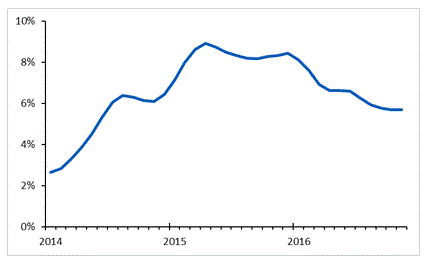The warehousing and distribution industry has been experiencing significant growth in recent years. As shown in the accompanying graph, total employment in the US warehousing and storage industry has been growing at a robust 6.3% year-over-year pace through November 2016 — much faster than the 1.8% growth rate for all US nonfarm jobs — and providing a strong follow up to the 8.4% growth experienced in 2015.
Employment growth year over year in the US warehousing and storage industry
Warehousing and distribution occupations have traditionally been one of the largest occupational segments of the industrial staffing market, with temporary workers comprising a high percentage of workers in these roles. An analysis of 2014 data from the Bureau of Labor Statistics in our Staffing Occupational Markets Guidebook shows that 18% of freight and stock movers, 18% of packers and packagers, and 11% of industrial truck (forklift) operators were employed by temporary staffing agencies. This represents an extremely high level of temporary agency usage when considering that only 2.0% of overall US nonfarm employment is via temporary staffing firms.
Drivers of growth
A major driver of growth in warehousing and distribution has been the rise of e-commerce and the shift toward online retail. The National Retail Federation reported that 44% of US consumers shopped online over the Thanksgiving extended weekend compared with 40% who shopped in stores. To accommodate fulfillment of online sales, a wave of new online retailers (such as Amazon) along with traditional retailers (such as Walmart) have been reconfiguring their distribution systems.
Another factor promoting growth in warehousing has been the influx of international freight being handled via shipping containers. Freight traffic (imports and exports) handled by the 20 largest US ports increased 11% from 2008 (the last cycle peak) to 2015, reaching 31 million shipping containers. Warehouses are often located in urban areas, such as California’s Inland Empire region, due to proximity to ports as well as to an urban population that can provide a supply of seasonal workers during the September to December holiday season.
A third driver of growth has been a trend of manufacturers and retailers to outsource their warehousing and logistics needs to third-party providers. As technology advances, third-party warehousing and logistics providers are increasingly able to offer services beyond basic storage. These value-added services include cross-docking, precise inventory management, advanced labeling and ticketing, and even order fulfillment and shipping.
Potential headwinds ahead?
The boom in the warehousing and distribution industry has provided myriad opportunities for industrial staffing firms, but serving this sector has not been without challenges. To give one example, the explosive growth of Amazon’s warehousing operations has been a boon to staffing firms, but this year Amazon decided to significantly reduce its staffing business with TrueBlue in favor of hiring temporary workers directly without the help of an agency. In October, TrueBlue reported that their staffing business with Amazon would fall from $355 million in 2015 to a projected $165 million in 2016, and decline further to a forecast of $30 million next year.
Another looming headwind for warehouse staffing is the trend of warehouse automation that is replacing the need for workers. This year, Amazon reported the use of 30,000 robots in its warehouses. The robots were designed by Kiva Systems, which Amazon acquired in 2012.
The bottom line
The warehousing and distribution industry appears to be experiencing an unprecedented era of growth and dynamism. For the industrial staffing firms that are able to meet the needs of their warehousing clients, there would appear to be much potential to expand along with their customers in both revenue and profits, at least in the near term.








